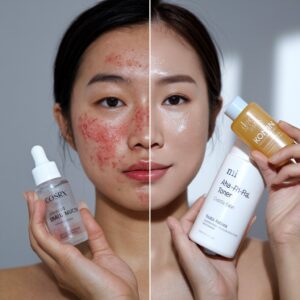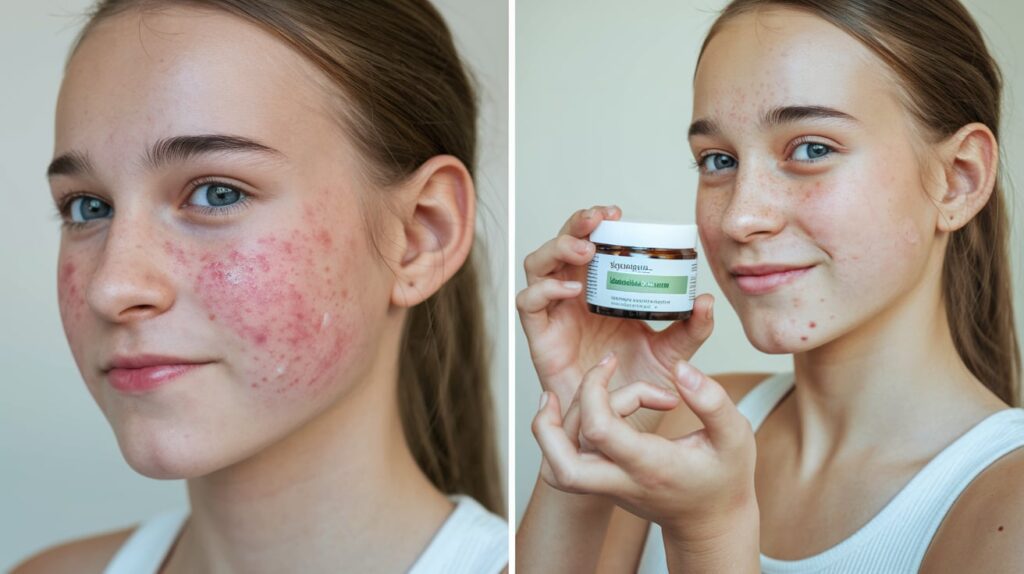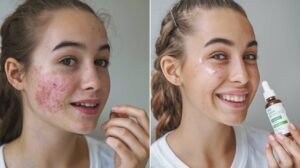Natural Acne Treatment For Teens: Science-Backed Remedies In 2025
For millions of teenagers, the reflection in the mirror can feel like a nightmare.
If you’re navigating the challenging world of acne and wondering, “How can I finally achieve clearer skin, naturally?” you are definitely not alone.
The truth is that around 85% of teens struggle with breakouts (JAMA Dermatology and British Association of Dermatologists), and the desire for effective, gentle solutions is universal.
For many of the 85% of teens affected, severe breakouts aren’t just a physical discomfort but a heavy emotional burden.
That’s why this post explores science-backed home remedies — proven methods that offer a genuine path to natural acne treatment for teens in 2025, empowering you with accessible, effective options right from your own home.
Finding truly effective, gentle solutions and establishing the proper skincare routine for acne can be overwhelming amidst the numerous options and conflicting advice.
Driven by an understanding of this common struggle and the search for reliable natural alternatives, I’ve delved into extensive research, gathering insights from other dermatologists and exploring diverse, evidence-based approaches to treatment, including methods such as the Korean Skincare Routine for Acne.
Science and experience consistently show that natural treatments, when chosen wisely and applied correctly, can be incredibly effective. They often offer significant benefits that are gentler on your skin and more cost-effective than many conventional products.
This comprehensive guide has been developed following a thorough examination of treating teenage acne naturally.
My goal is to equip you with clear, trustworthy, and accessible strategies to help you overcome the noise of trial and error.
Let’s move forward with hope, providing you with the knowledge and tools to pursue clear, healthy skin and reclaim your confidence.
Why Do Teenagers Get Acne on Their Face?

Teenagers get acne on their face mainly due to hormonal changes during puberty. Increased oil (sebum) production clogs pores, leading to pimples and blackheads. Bacteria, dead skin cells, and excess oil contribute to breakouts. Genetics, stress, and poor skincare habits can also worsen acne in sensitive or oily skin teens.
These blocked pores create an ideal environment for common skin bacteria, specifically Propionibacterium acnes, to multiply rapidly, triggering inflammation.
This inflammatory process results in the characteristic acne breakouts, appearing as pimples, blackheads, and whiteheads.
Understanding the root causes of teenage acne is vital for effectively addressing this condition.
While a common struggle, the resulting breakouts can unfortunately contribute to a heavy emotional burden, making targeted solutions necessary.
For deeper insights into skin health and renewal, explore our guide on cellular skin renewal tips.
How Hormonal Changes During Puberty Lead to Acne Breakouts?
During puberty, fluctuating hormones, particularly androgens, increase the activity of oil glands.
This surge in oil production (sebum) can overwhelm skin pores, leading to clogged pores.
These conditions create a fertile environment for acne-causing bacteria, such as P. acnes, which ultimately results in acne breakouts on the face.
Can Certain Foods Trigger Teenage Acne Breakouts?
Research suggests a connection between diet and the development of acne. Certain foods, such as dairy, refined carbohydrates, and greasy items, may contribute to acne breakouts.
They can potentially trigger inflammation or affect oil production, contributing to pimples and other skin blemishes.
Can Stress Lead to Teenage Acne Breakouts?
Stress is common during the teenage years due to pressures such as school and social life. While not a direct cause, stress can influence hormones, potentially leading to increased oil production and inflammation.
This connection means periods of high tension might worsen or trigger acne breakouts on the skin.
What Are Common Types of Teenage Acne Breakouts?
Acne appears in various forms, often referred to as acne spots or lesions.
Common types of acne include non-inflammatory ones, such as whiteheads and blackheads, which are caused by clogged pores.
Inflammatory breakouts include red pimples (papules), pus-filled pimples (pustules), and more severe, painful cysts and nodules deeper under the skin.
Identifying the type is crucial, as different types of acne require distinct treatment approaches.
Kitchen Cabinet Heroes: Natural Ingredients
Think your pantry’s just for cooking? Think again. Some of the best acne-fighting ingredients are already sitting in your kitchen. From honey to green tea, these natural remedies are gentle on teen skin and backed by science, proving that effective acne care doesn’t have to come in a bottle.

How Honey’s Antibacterial Powers Help Fight Acne?
Honey’s antibacterial powers make it an effective natural remedy for acne-prone skin. It targets acne-causing bacteria (P. acnes), reduces inflammation, and soothes breakouts without harsh side effects. Its anti-inflammatory properties help calm redness and irritation. Use a honey face mask regularly to support clearer, healthier skin naturally.
How to Use Tea Tree Oil Safely for Acne?
Tea tree oil is a powerful natural ingredient for treating acne. It is effective in battling acne-causing bacteria and reducing inflammation, which helps target pimples and breakouts. It’s beneficial as a targeted spot treatment, even for more stubborn cystic acne, by helping reduce swelling and aiding healing.
Always dilute tea tree oil properly with carrier oil or water before applying it to the skin to avoid excessive drying or irritation. Pair it with organic skincare solutions for a holistic approach.
How Apple Cider Vinegar (ACV) Helps Fight Teenage Acne?
Apple cider vinegar (ACV) is explored as a natural treatment option for acne, particularly in skincare routines for teens. Its acetic acid content may help balance the skin’s pH and act as a natural astringent, aiding in deep cleansing of pores and potentially reducing inflammation.
This action can help dry out existing blemishes and prevent breakouts. It’s often used diluted with water as a toner. Always dilute ACV properly before applying it to the face, as undiluted solutions can be too harsh for the skin.
What Are Green Tea’s Benefits for Acne-Prone Skin?
Green tea benefits acne-prone skin with its powerful antioxidants and anti-inflammatory properties. It helps reduce redness, swelling, and irritation from breakouts. Use it as a toner, spot treatment, or in cooling green tea ice cubes. This natural remedy supports clearer skin. Pair with cucumber for a soothing, acne-fighting skincare routine for added results.
Daily Skincare Routine for Acne-Prone Skin
Creating a daily skincare routine is key to managing acne-prone skin, especially for teens. Consistently using gentle, non-comedogenic products helps remove excess oil, unclog pores, and reduce breakouts. Over time, this simple yet effective routine promotes clearer, healthier skin naturally and sustainably.
What Are the Best Morning Cleansing Steps for Acne?
The morning cleanse is a crucial foundation for managing teenage acne. Use a gentle cleanser specifically designed for acne-prone skin to gently remove overnight oil and impurities without stripping the skin.
- Cleanse using lukewarm water and a soft cloth.
- Look for calming natural ingredients, such as aloe vera or chamomile.
- Finish by splashing on some cool water. Proper morning cleansing steps help prepare your face and pores for the day.
- If you have sensitive skin, consider checking out the best organic face wash for sensitive skin to ensure your cleanser isn’t aggravating your acne.
Natural Toner Recipes: Balancing Skin for Acne?
Toning helps balance the skin’s pH and prepares it for treatment. Skip alcohol-based options for natural toner recipes targeting acne-prone skin and breakouts.
- Apple cider vinegar (ACV) and witch hazel: ACV helps calm inflammation, acts as an astringent to cleanse pores, and can help dry existing blemishes. Always dilute ACV.
- Green Tea or Rose Water: These natural toners are soothing, contain antioxidants, and benefit irritated acne spots. They support clearer skin by removing impurities and balancing the face.
- For a gentle, hydrating toner alternative, try rice water for glowing skin, which can help soothe acne-prone skin while providing essential moisture.
How to Choose a Moisturizer for Acne-Prone Skin?
Moisturizing is essential for maintaining hydration in acne-prone skin.
Select a lightweight, non-comedogenic moisturizer specifically formulated to prevent clogged pores and exacerbate acne.
Proper hydration helps prevent the skin from overproducing oil.
- Look for oil-free formulas.
- Ingredients like hyaluronic acid provide hydration without heaviness.
- Consider adding a few drops of non-comedogenic oils, such as jojoba or rosehip, for added skin benefits.
- Finding the right balance can be challenging for individuals with dry skin and acne. Our guide on the 10 best soaps for dry skin may be helpful, as many of these gentle cleansers also work well for acne-prone skin.
- Always finish your morning skincare routine with sunscreen to protect your skin from UV damage. If you have sensitive skin, check out our recommendations for the best organic sunscreens for sensitive skin.
What Are the Best Nighttime Acne Treatment Steps?
Your evening is key for treating and preventing acne breakouts.
Follow these nighttime skincare routine steps for acne-prone skin:
- Double-cleanse: Start with an oil-based cleanser to remove makeup, SPF, and oil, followed by your regular gentle face wash.
- Apply targeted acne treatment: Serums or spot treatments with ingredients like salicylic acid or retinoids help unclog pores and address pimples.
- Finish with a soothing, non-comedogenic moisturizer. This routine helps repair the skin and clears breakouts overnight, supporting your acne treatment goals.
- If you have acne scarring or hyperpigmentation, consider incorporating some of skincare ingredients for hyperpigmentation into your nighttime routine.
Lifestyle Changes That Clear Your Skin
Discover lifestyle changes that clear your skin and manage teenage acne breakouts. Simple everyday habits significantly impact acne, helping you regain control.
Discover top lifestyle factors that can help achieve clearer, healthier skin beyond traditional treatments.
How Does Lack of Sleep Affect Teenage Acne?
Lack of sufficient, quality sleep can significantly impact teenage acne. Not getting enough rest triggers a stress response, potentially increasing inflammatory hormones contributing to clogged pores and worsening acne breakouts.
- Aim for 7-9 hours nightly.
- Maintain a consistent sleep schedule. Prioritizing sleep supports overall skin health and may reduce breakouts, aiding acne treatment.
What Are Exercise Benefits for Acne-Prone Skin?
Exercise offers significant benefits for skin, including aiding acne management.
Physical activity increases blood flow, delivering vital nutrients and helping flush toxins that can contribute to breakouts.
- Exercise is also a natural stress reliever, helping regulate acne-related hormones.
- Remember to cleanse your face promptly after a workout to prevent clogged pores from sweat and oil. Regular exercise supports clearer, healthier skin as part of a well-rounded lifestyle.
Effective Stress Management Techniques for Acne
Stress and anxiety are known factors that can aggravate acne by influencing hormones like cortisol.
Finding healthy ways to manage stress is crucial for skin health and reducing breakouts.
- Explore stress management techniques like meditation, journaling, or deep breathing exercises.
- Prioritize activities that help you relax and decompress. Reducing tension supports hormonal balance and benefits your complexion, helping minimize acne breakouts and supporting your acne treatment goals.
What Foods Can Help Fight Teenage Acne?
While certain foods may aggravate acne, others can support clearer skin. For acne-prone skin, focus on incorporating foods that help fight acne into your diet.
- Include items rich in zinc (like nuts/seeds) and antioxidants (like berries, leafy greens).
- Minimize inflammatory foods mentioned previously.
- Stay well-hydrated; drinking water is crucial for flushing toxins and maintaining healthy skin. To complement your acne care, explore our guide on anti-aging prevention in your 20s for a youthful glow.
When to Combine Natural & Medical Treatment
Finding the right balance in acne treatment is key. Learn when to combine natural and medical treatments for effective results.
This integrated approach, combined with patience, can help clear breakouts and regain control over acne-prone skin without relying on single solutions.
What Are the Signs of Severe Acne?

Severe acne is marked by deep, painful cysts or nodules under the skin. These inflamed breakouts are often tender and may cause permanent acne scars.
Recognizing these signs early is essential. If you experience severe acne, consult a dermatologist for targeted, professional treatment to prevent long-term skin damage.
When Should a Teenager See a Dermatologist for Acne?
Consulting a dermatologist is vital when acne is severe or not responding to basic care, especially for teenage acne. A dermatologist provides a professional diagnosis and a thorough skin exam.
- They explain various acne treatment options.
- Offer guidance on combining natural and medical treatments.
- Tailor recommendations to your specific type of acne and needs. Seeking professional help empowers a more effective path to clearer skin.
Combining Natural Ingredients with Prescription Acne Treatment?
Many dermatologists recommend combining natural ingredients with prescription acne treatment for enhanced results on acne-prone skin.
Natural anti-inflammatories and antimicrobials can complement medications like retinoids.
- Examples include tea tree oil, sulfur, or oral probiotics.
- This combination therapy can target multiple causes of acne. Working with a professional helps integrate natural treatments safely alongside prescription medications for effective acne management and improved breakout control.
- Suppose you’re interested in exploring other natural approaches to skin health. In that case, our article on natural anti-aging mechanisms may be helpful, as many of these principles also apply to acne prevention.
Read more on retinoids — explore our in-depth guide: Exosomes vs. Traditional Retinoids: Which Delivers Better Skin Renewal?
How to Track Your Acne Progress Effectively?
Tracking acne progress is essential to staying motivated and seeing improvements over time. It helps combat discouragement during the acne treatment journey for teenage acne.
- Take photos of your skin regularly, using the same lighting and angle.
- Jot down notes on breakouts, redness, texture, and how your skin feels.
- Note any changes in your skincare routine or lifestyle. If applicable, consider integrating male skin regeneration secrets for advanced care.
Conclusion: Natural Acne Treatment for Teens
Your acne journey doesn’t have to be overwhelming. Science-backed natural acne treatments and simple home remedies using kitchen ingredients can make a real difference. Building a consistent skincare routine for teens, improving sleep, diet, and stress management, and understanding why teenage acne occurs are key steps toward clearer skin.
Give new methods 2–3 weeks to show results, and seek a dermatologist’s guidance if acne is severe or persistent. Combining natural and medical approaches offers the best outcomes. With patience and knowledge, achieving clear, healthy, confident skin is absolutely possible—start your journey today!
Looking for more skincare tips? Check out these related articles:
- Vitamin E Oils for Skin: Benefits and Top Picks for 2025
- The Dove Sensitive Skin Beauty Bar: A Gentle Option for Acne-Prone Skin
- Top Eye Serums for Dark Circles in 2025
- Innovative Mushroom Skincare: Hey Bud’s Mushroom Magic
FAQs: Natural Acne Treatment for Teens
What Is The Best Diet For Acne?
The best acne diet includes foods rich in zinc, antioxidants, omega-3 fatty acids, and probiotics. Focus on leafy greens, berries, and salmon while limiting sugar, dairy, and refined carbs that raise insulin and trigger inflammation. A clean, balanced diet supports hormone balance and promotes clearer skin naturally.
For a deeper understanding of probiotic vs prebiotic efficacy in skincare, explore our evidence-based analysis.
Is Milk Bad For Teenage Acne?
Yes, especially skim milk, which can increase hormones like IGF-1 that stimulate sebum production and clog pores. Teens prone to acne should replace dairy with plant-based alternatives such as almond or oat milk to reduce breakouts and inflammation while maintaining a nutrient-rich, skin-friendly diet.
What Fruits Are Good For Teenage Acne?
Fruits rich in vitamin C, beta-carotene, and antioxidants—like oranges, papaya, blueberries, and kiwi—help reduce acne inflammation and support collagen formation. These nutrients strengthen the skin barrier and repair damage caused by free radicals, making them ideal for teens battling persistent acne breakouts.
Read more: Explore our full guide on The Best Fruits for Glowing Skin.
What Is The Best Cure For Teenage Acne?
The best teenage acne cure combines a gentle skincare routine, balanced nutrition, and stress control. Use mild cleansers, oil-free moisturizers, and acne treatments with salicylic acid or benzoyl peroxide. Consistency and patience are key—if acne persists, a dermatologist can recommend prescription treatments or tailored combination therapy.
Can Teenage Acne Go Away?
Yes, teen acne usually fades as hormones stabilize, often by early adulthood. However, proper skincare, diet, and lifestyle habits accelerate healing and prevent scarring. Following a consistent acne routine, reducing sugar and stress, and avoiding harsh products can significantly minimize breakouts and long-term skin damage.
What Is The Teenage Acne Diet?
A healthy teenage acne diet limits dairy, refined carbs, and sugary foods while focusing on whole grains, fruits, vegetables, and lean proteins. Nutrients like zinc, omega-3s, and antioxidants help balance oil production and inflammation. Staying hydrated and eating balanced meals support clear, radiant skin over time.
Why Is Teenage Acne So Bad?
Teen acne worsens due to hormonal surges during puberty that increase oil production and clog pores. Stress, processed foods, and improper skincare can make it more severe. Hormonal fluctuations combined with bacteria buildup often cause deep, painful pimples that require consistent care to manage effectively.
What Foods Are Bad For Teen Acne?
Foods like dairy, sugary snacks, fried fast food, and white bread can worsen teen acne by raising insulin and androgen levels. These hormonal spikes increase sebum and inflammation. Replacing these with whole foods, fiber, and antioxidant-rich meals can noticeably reduce acne flare-ups and oiliness.
What Is A Teenage Skincare Routine For Acne?
A simple routine works best: cleanse twice daily with a gentle, non-comedogenic cleanser, use an oil-free moisturizer, and apply broad-spectrum SPF 30+ sunscreen daily. Add targeted acne treatments like salicylic acid or tea tree oil. Consistency and avoiding harsh scrubbing help calm irritation and promote clear, balanced skin.
Disclaimer: GlowGuide participates in the Amazon Services LLC Associates Program, an affiliate advertising program designed to provide a means for sites to earn advertising fees by advertising and linking to Amazon.com. As an Amazon Associate, I earn from qualifying purchases. If you click on an Amazon link on my site and make a purchase, I may earn a commission at no extra cost to you.


